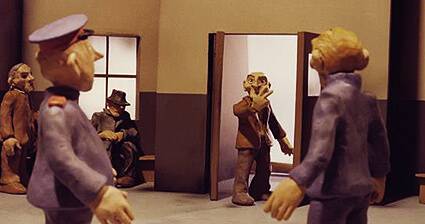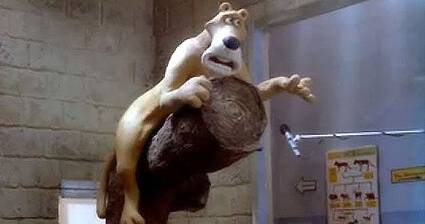Remembering ‘Lip Synch’ with Aardman’s Nick Park & Peter Lord
This Wednesday Aardman in association with Encounters will put on a not-to-be-missed Bristol screening of the formative work that helped cement the studio’s reputation as a force of British animation. Hosted by Kieran Argo and Helen Brunsdon, Lip Synch: A 25 Year Celebration will take place at Bristol’s Watershed and feature a rare chat with key animation talents Peter Lord, David Sproxton, Nick Park, Barry Purves and Richard ‘Golly’ Starzak as well as producer Sara Mullock.
Lip Synch, a short film ‘package’ produced by Aardman for Channel 4 in 1989 expanded on the techniques used for earlier shorts series Animated Conversations and Conversation Pieces, consisting of five early outings for now-established directors: War Story, Going Equipped (Dir. Peter Lord), Ident (Dir. Richard Starzak), Next (Dir. Barry Purves) and the Oscar-winning Creature Comforts (Dir. Nick Park of Wallace & Gromit fame). Recently Skwigly leapt with childlike propulsion at the opportunity to discuss some of these early projects with directors Nick Park and Peter Lord.
From your perspectives how established was Aardman back in those days, and how did the relationship with Channel 4 come about?
Nick: I knew of Morph and everything that Pete and Dave were doing but it was when they were doing Animated Conversations no one had seen that kind of serious animation before, based on real people and what they said. I remember my Dad commenting on just how empathetic Down & Out was, because it was based on real-life observations of how people are.
Peter: We made that film for very little money for the BBC. It was very unusual from every point of view at the time, because nobody was doing plasticine, documentary style films, sort of adult in theme and tone. It didn’t make a splash, just tiny little ripples; the animation community was very small then, there were only a few art schools and film schools. It later proved its worth when, in the early 80s, Channel 4 started up. I’m aware this is ancient history now but when they started they were briefed to do various things for various minorities, and included in those minorities were animation enthusiasts.
Down & Out (Dir. Peter Lord/David Sproxton), an early Aardman short made for the BBC’s Animated Conversations series in 1978
They decided to have an animation strand and kicked off with a lot of ambition and funding, we showed them Down & Out and they said “Yes! Ten like that!”
We didn’t do ten in the end, we did five called Conversation Pieces and then Lip Synch continued that trajectory.Nick: Aardman was very small at that time, taking on new people and branching out into all sorts of commercials. I remember we sat down with Golly and Barry thinking it would be a great opportunity if we went to Channel 4 with an idea, but we could never really agree on one. We came up with Lip Synch as a sort of continuation of that idea and they accepted it as an Aardman ‘package’ of different, diverse ideas.
Peter: These did have such a ripple effect; so much came from Creature Comforts.
On that topic, what was the germ of that idea to take these people’s testimonies and put them to zoo animals?
Nick: I think the main thing was really based on what Pete and Dave had already been doing, they would have someone go out with a microphone amongst some people. Some of them were quite set up, weren’t they?
Peter: Some of them were, like in Late Edition, it was done at the offices of a Bristol listings magazine. For that occasion two of them had radio mics on, so in that sense it was set up.
Creature Comforts (Dir. Nick Park)
Nick: It was basically carrying on the same tradition, but this time with animals in the zoo, that was the only real difference. I went around Bristol Zoo with a hidden microphone. The idea was to try and record what people said about the animals but reverse it so the animals were saying these things about people “Look at that strange looking thing, what’s he doing?” But the recording situation was never that good, or easy – and the zoo didn’t really want me to record there either! Afterwards I thought Why not just go up to people? We’d done some vox pops as a test, going up to people outside the zoo and asking them what they thought about zoos and animals in cages and stuff. It was good but people all said the same thing, really: “Nice to see the animals, pity they’re locked up”
So myself and an interviewer went to people – some who we knew – in their houses, small flats, old people’s homes and student accommodations to give a view on what it’s like being in the UK, things that were a bit parallel to animals being dissatisfied with their environment. And I happened to find this Brazilian student Marcio who just loved ranting about how he hated living in Britain compared to the hot, Brazilian weather. He stole the show, he was a great find!Peter: Who’s the terrapin guy?
Nick: He’s a friend of mine actually. He lived in a very small flat, I almost did him as a kind of test really to see what would happen and he ended up in the film.
Peter: I’m sure he’s a lovely man but he got such a hilarious voice to me, almost like a Mike Leigh caricature.
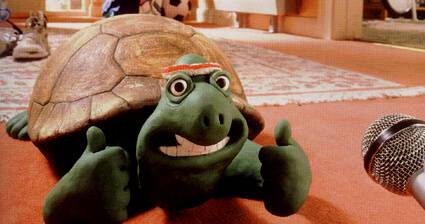
Creature Comforts (Dir. Nick Park)
How soon did you realise you’d created something that resonated so much with audiences and the industry?
Nick: Suddenly scripts from agencies started coming in – can we have an advert for this and that, with animals talking? Strangely enough they’d all obviously have to be written to advertise the product, which wasn’t what we had done. So getting people to mention products was difficult without it seeming contrived and written. That’s when the electricity ads came in from GGK, they said “Just record it and if they happen to mention electricity that’ll be good” (laughs) so we did the same thing again with pandas, penguins, tortoises, all sorts.
Peter: Everyone thought they were for gas, didn’t they?
Nick: Yeah, they didn’t work at all!
Peter: They were kind of disastrous! Well, not disastrous, they were the most loved thing of their era – but everyone thought they were for gas rather than electricity because they associated gas, for some reason, with cuddliness and cosiness, while electricity was cold and technical.
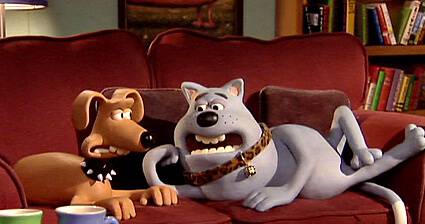
Characters from the Creature Comforts ITV series (Dir. Richard Starzak). produced 14 years after the original short
It also translated very well to the show many years later. Was there a particular reason it was such a long time for it to become a series?
Nick: There was a point when I know we had downtime and were thinking we needed to generate something to keep animators employed. Creature Comforts and Shaun the Sheep came up at the same time as series ideas. Creature Comforts got off the ground first really, it was kind of an easier thing to get going I suppose, as it didn’t need writing as such, just lots of recording and editing, getting the soundtracks together, finding the public that would make great voices. Golly was at the driving seat of all that.
Obviously both Shaun and Creature Comforts are both very successful ventures and Golly is such a big part of the Aardman spirit, how does that feel seeing these things have such a life beyond your initial ideas?
Nick: It’s great! I think Pete’s probably better at this than I am but I find it hard to let go when you’ve been very involved with the creation, though I’ve learned over the years. With someone like Golly you really trust him, he’s got an incredible track record and an incredible, individual, quirky humour.
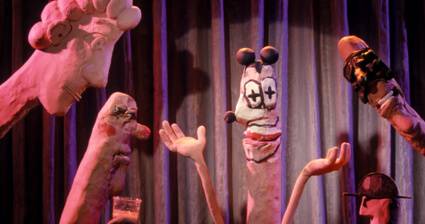
Ident (Dir. Richard Starzak)
This humour is evident in Richard’s own contribution to Lip Synch. Titled Ident, it details a day in a life of a painfully relatable everyman, wandering his labyrinthine existence whilst cowed by insecurities and social impropriety. Making use of excellent comedic devices – to this day I’m still speculating what it was that Chas did – that would stand the director in good stead when helming later series (including Rex The Runt produced outside of Aardman), beneath the humour and design simplicity is a story tinged with real human fears about how we’re perceived by the world and the desire to perform to the expectations of others to be accepted, a subject which in this era of social media desperation is more timely than ever.
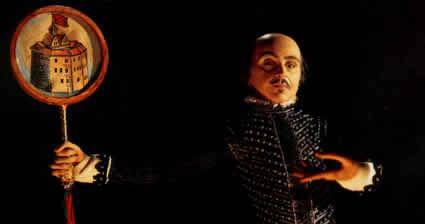
Next (Dir. Barry Purves)
Another contribution came from Barry Purves, who set a high creative bar for himself (one which he has continued to meet throughout his subsequent career) with Next. The film, an homage to the most memorable characters, moments and set pieces of Shakespearean literature, sees the Bard himself enacting his own work, ‘auditioning’ for the benefit of RSC founder Peter Hall. With little more than an assortment of props and a long-suffering mannequin to assist the telling, it is the masterful performance of the Shakespeare puppet itself that carries the film through, scored to a lavish, Renaissance-flavoured tune by the late Stuart Gordon. Barry carried on a career in childrens’ television alongside personal short film work for older audiences, forging a strong association with the impeccable puppetry of MacKinnon and Saunders and lending his expertise to such feature film productions as King Kong and Mars Attacks.
Both Richard and Barry’s shared trait of largely sidestepping dialogue (though Ident does indulge its own brand of curiously understandable nonsense-speak) in their films treats the collective title Lip Synch looser than Aardman co-founder and director Peter Lord, later to direct the features Chicken Run and The Pirates! In An Adventure With Scientists. Carrying forward the approach taken with the earlier Conversations series, War Story and Going Equipped are wonderful examples of using the same initial idea of a recorded interview edited into a monologue, though with quite different visual interpretations.
Peter: On the Conversation Pieces series we didn’t have a big budget, I think we made fifteen recordings hoping to make five films, and of those fifteen two were satisfying recordings and two more we kind of made a virtue out of necessity and told stories that were not dynamic. We’d try to build stories around the rather non-dynamic material we had, so it was much easier to break away and do interviews. The funny thing about interviews is in both those films, when you take out the interviewer and the audience isn’t reminded of the microphone it feels confessional, even though actually they’re being asked questions.
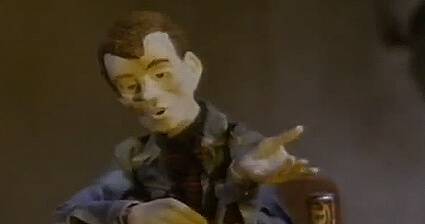
Going Equipped (Dir. Peter Lord)
Going Equipped stands out as being the more sombre of the films, was this always the plan?
Peter: Going Equipped was interesting for me because I do remember being influenced by Yuriy Norshteyn’s film The Overcoat, which he never finished. It’s all very slowly paced and observational, some of it’s very beautiful cutout animation. That sort of influenced me a bit. Actually with Going Equipped David and I decided to not raise a smile at all; while it’s hard to get a laugh in anything, it’s possible to raise a smile, get a chuckle, and we thought we’d try to avoid that. There were opportunities in there but we didn’t go there, we just thought as a formal experiment we’d just try and make it so that it doesn’t try to make people laugh, so it’d just be about empathizing with the interviewee.
In a lot of respects the film’s atmosphere comes through in the minutiae of the interviewee’s surroundings.
Peter: It was nice to do, we built these little live-action sets, bits of his cell, bits of his living room, bits of his bedroom and shot these strange, atmospheric little pieces there. Then we did the raindrops on his face, which is totally ripped off from Blade Runner. At the time we thought That’s cool! Let’s do that! but it was very difficult to do in stop-motion because we had a separate projector for the rain. We’d shot water running down a glass pane in live action, so that was on film, and we wanted to project it onto his face while he was animated so we had to do that frame by frame. The trouble is, when you’re trying to project frame by frame, in those early days you’d burn the film if a frame was held too long. So there was some elaborate but hilariously primitive Heath Robinson system where you pressed a button and the projector would come alive, you’d take the film frame and it would die down again, so it would only light up long enough for you to take your frame. There was also a terrible, ramshackle device which represented a car driving outside. We had two headlights on a tripod that was dragged along the floor on a chain, so when you press the button to take a frame, this thing would clatter along the floor slowly, frame-by-frame, the same time the projector was going. I like those things, it was fun, everyone gets into that.
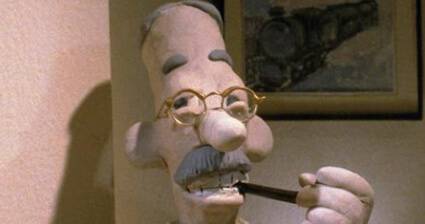
War Story (Dir. Peter Lord)
War Story, by contrast, plays into the comedic potential of the source recording, was the idea to create such an effective juxtaposition with the two films?
Peter: When Going Equipped was finished I remember looking at it and thinking Oh great, well done Pete. You’ve made a film that nobody enjoys, with great effort. (Laughs) Because it’s difficult with a serious film, you don’t hear a room of people laughing.
To me like it always felt like a slightly unloved film by the rest of the world, although I like it a lot and am proud of it. Therefore War Story was almost a subconscious attempt to be more populist, I would say. In fact I’ve got drawings somewhere of a whole other version of War Story. I first got to making another sort of semi-mournful film about his life, because there were other parts of his story; he was bombed or involved in an air raid at the BAC Works in Filton and clearly he’d suffered some sort of shellshock. He mentioned that and there were other parts of his life that weren’t all jokes, so for that two hour recording I could’ve made this thoughtful film but I decided to make the funnier version in the end.
To find out more about the work of fellow Lip Synch directors Barry Purves and Richard Starzak you can listen/download the Skwigly Podcast episodes 2 and 11 respectively.
Lip Synch: A 25-year Celebration takes place Wednesday December 10th, 6:30pm at Bristol’s Watershed, with an 8pm drinks reception to follow. For more information and to book tickets click here.


